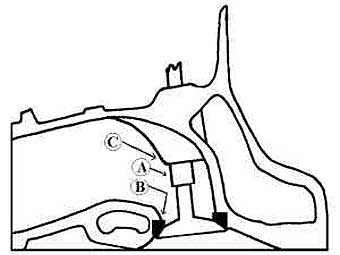
Cylinder head porting guide
Porting the Buick 300 Head
By: Kurt Schley(This article appeared in Volume IX Issue 3, September 2001.)
Achieving the most efficient port shape for any normally aspirated engine requires the use of an accurate flow bench, an experienced operator and lots of money. However, some basic home porting with simple tools can yield significant improvements in performance. Have the machine shop install the larger valve inserts, shorten the bottom of the valve guides by about 0.25", install the guide liners, and chamfer/taper the cut guide edge (A). Don't have them do any valve grinding or installation yet and do not get carried away and have more of the guide length removed even though it creates quite a bit of obstruction. The shorter the guide the more potential there is for valve wobble. As importantly, the guides provide significant cooling for the valves.
Your first at-home task is to smooth and match the transition from the port to
the valve seat insert (B) On the stock 300 heads, there is usually a pronounced
lip immediately behind the insert where the port is actually a little larger in
diameter than the insert. The gas/air flow impinges on the back of the insert
and creates power robbing turbulence and back pressure. The transition between
the port and the new, larger valve seat insert must be smoothed using a hand
grinder. Remember that the head is relatively soft aluminum and it is easy to
remove too much material! You want to just match the edges of the insert and the
port, do not try to enlarge the port itself as this will slow down the charge
velocity.
|
Enjoying this article? Our magazine is funded through the generous support of readers like you! To contribute to our operating budget, please click here and follow the instructions. (Suggested contribution is twenty bucks per year. Feel free to give more!) |
The next area of attention is the aluminum boss holding the valve guide (C).
The step from the boss to the smaller diameter guide adversely affects a smooth
flow. With a long shank on the grinder, taper the boss gently down to the guide,
being careful not to nick or gouge the guide itself. Now it is time to examine
the walls of the ports behind the valves. As aluminum head casting technologies
in 1964 were not up to today's standards, the port wall are sometimes excessively
rough. These can be carefully lap sanded, again taking care to even out the walls
while not actually enlarging the ports. Do not polish the walls to a perfectly
smooth finish, as a certain port wall roughness is needed to keep the fuel in
suspension in the air stream.
Now the heads can be returned to the machine shop for valve installation and a
good three angle valve job.
Disclaimer: This page was researched and written by Kurt Schley. Views expressed are those of the author, and are provided without warrantee or guarantee. Apply at your own risk.
Disclaimer: This page was researched and written by Kurt Schley. Views expressed are those of the author, and are provided without warrantee or guarantee. Apply at your own risk.

